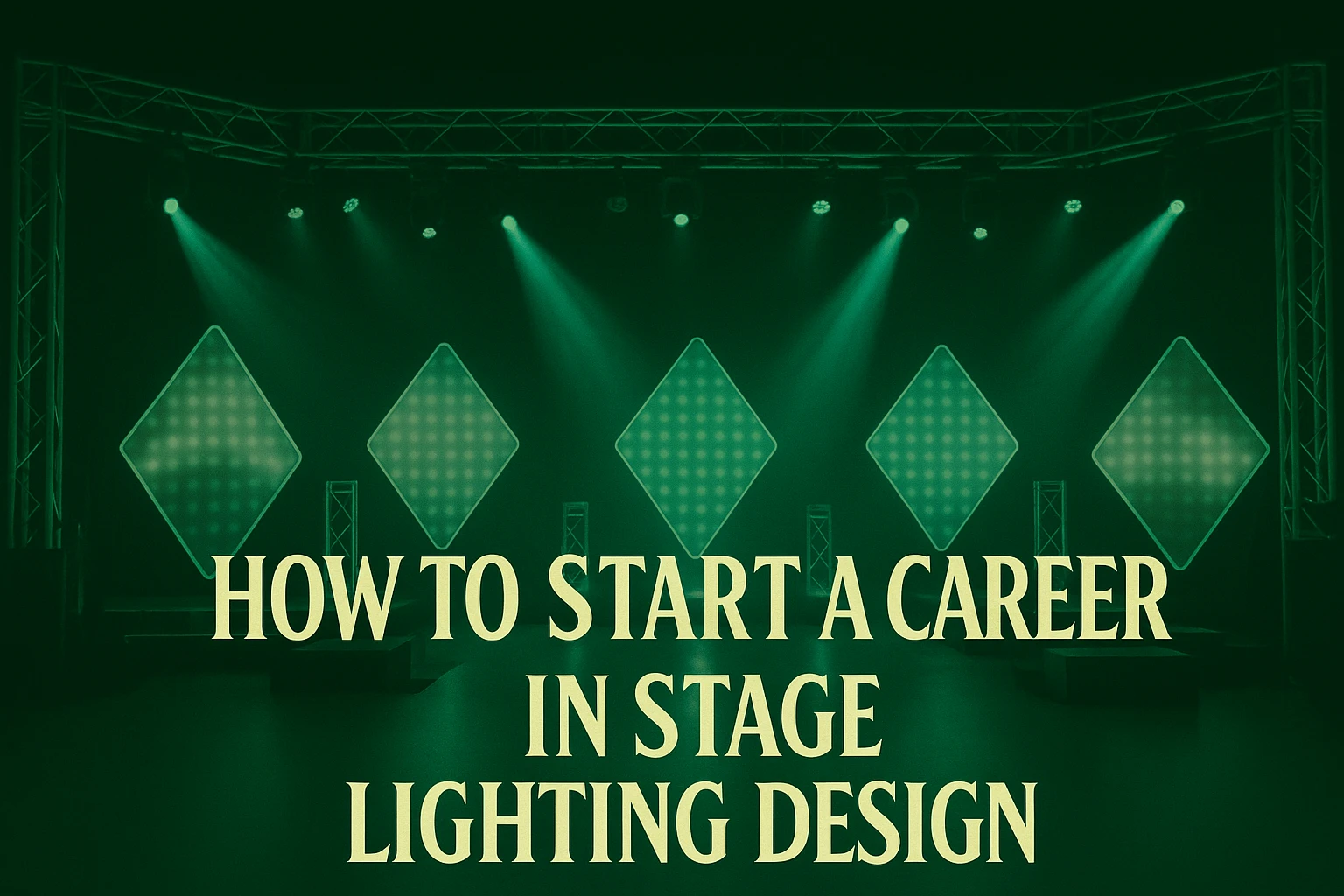Beginner’s Guide: How to Start a Career in Stage Lighting Design

Stage lighting design has evolved from basic candlelit settings to intricate digital displays, becoming an art form driven by creativity and technical prowess.
Understanding the foundational principles of lighting design is essential for anyone looking to enter this exciting field. This includes grasping the science of lighting positions and angles, as well as mastering color theory to evoke the right mood and atmosphere. Familiarity with both traditional and cutting-edge lighting equipment is crucial, from conventional spotlights to the latest in LED technology, ensuring you can select the right tools for any production.
This beginner’s guide will navigate you through the journey of becoming a stage lighting designer, from planning and executing effective lighting designs to collaborating with directors and integrating special effects. Discover various career paths, learn from real-world cases, and find resources that will aid in maintaining and enhancing lighting systems, setting you on the path to illuminating the world of theater.
The Evolution of Stage Lighting
The evolution of stage lighting is a fascinating journey that reflects technological and artistic advancements.
Key Milestones in Stage Lighting Evolution
Era | Milestone |
|---|---|
16th century | Use of candles and oil lamps |
19th century | Introduction of gas lighting |
Late 19th century | Electric lights revolutionize theatre |
20th century | Introduction of control systems |
21st century | LED technology and smart controls |
Initially, stage lighting relied on simple tools like candles. The shift to gas lighting in the 19th century enhanced stage visibility but had safety concerns. Thomas Edison’s invention of the incandescent bulb brought the next big leap, offering brighter and safer options for theatrical productions.
Today, LEDs and advanced control systems dominate the landscape of stage lighting. They provide amazing lighting effects, creating dynamic performance spaces. Modern lighting design integrates technology with artistry, paving the way for effective lighting design.
For beginners in stage lighting, understanding these historical advancements offers common sense advice. It illustrates how technology continues to shape the future of stage lighting, ensuring that rigging theory and special effects keep evolving. Whether you’re an amateur theatre enthusiast or a professional lighting designer, the history of stage lighting is an excellent introduction to its current opportunities and challenges.
Fundamental Principles of Lighting Design
Lighting design is an art that blends science and creativity. At its core, it is about creating the right mood and focus for a performance. When crafting a lighting design project, the goal is to enhance the story being told on stage. Effective lighting design involves mastering both technical skills and artistic instincts. It requires an understanding of the equipment, control systems, and various aspects of stage lighting. This knowledge allows lighting designers to create amazing lighting effects. Such effects transform a performance space, making it engaging and immersive for the audience.
Understanding Lighting Positions and Angles
The placement of lights and the angles at which they hit the stage are crucial in lighting design. These elements determine how features and textures are seen by the audience. Learning these positions and angles is key for beginners in stage lighting. For example, front lighting is essential for illuminating performers’ faces. Side lighting can add depth and dimension, while backlighting creates silhouettes and dramatic effects. Exploring these angles ensures a balanced and dynamic visual experience. This understanding is a vital step into theatre lighting. It lays the groundwork for more sophisticated lighting effects in future designs.
Exploring Color Theory in Lighting
Color theory in stage lighting involves knowing which colors to use to evoke certain emotions. Warm colors like red and orange can create a cozy, inviting feel. Cool colors like blue and green might lend a scene a calm or mysterious vibe. Lighting designers use gels and digital control systems to alter colors. Mastery of color theory is essential for achieving the desired emotional responses in the audience. It allows designers to elevate storytelling through the art of lighting design, truly showcasing their vision.
Familiarizing with Lighting Equipment
Lighting equipment is the backbone of any stage production. Understanding the tools involved will set a solid foundation for anyone looking to start a career in stage lighting design. This involves not only knowing what each piece of equipment does but also how and when to use them. From creating effective lighting design to crafting amazing lighting effects, mastering the different tools is key for beginners in stage lighting. Whether you’re a school pupil or an amateur theatre enthusiast, gaining knowledge in these areas is an excellent introduction to the landscape of stage lighting. Let’s explore the various types of equipment you’ll encounter in this field.
Overview of Traditional Lighting Tools
Traditional lighting tools have been the cornerstone of stage lighting for many years. These tools include spotlights, floodlights, and dimmers. Spotlights are perfect for focusing on key performers or elements, while floodlights provide broader illumination. Dimmers control the brightness of lighting units, offering flexibility in the lighting design process.
Understanding rigging theory, which involves setting up and securing these lights, is crucial. The proper use of these tools can transform a simple performance space into a visually compelling scene. They allow you to convey emotion, draw attention, and enhance storytelling. For theatre professionals and beginners alike, having a good grasp of these tools is essential. Knowing how they work can help you execute both basic and complex lighting design projects with confidence.
Modern Innovations in Lighting Technology
The world of stage lighting is evolving with modern innovations that bring new possibilities to the art of lighting design. Advanced control systems now allow for greater precision and creativity. These systems can be set up to automatically sync lights with music or dialogue, creating special effects that are both captivating and dynamic.
LED fixtures are another significant advancement. They are energy-efficient, have a longer life span, and offer a wider range of colors compared to traditional bulbs. Such innovations are reshaping the future of stage lighting by providing new tools and methods for lighting designers to experiment with.
For those stepping into theatre lighting, understanding these technological advancements is key. They not only expand what is possible in lighting design but also introduce efficiencies that are essential as the lighting industry evolves. Thus, keeping updated with these innovations is crucial for anyone looking to make a lasting impact in their lighting journey.
Selecting the Right Tools for Productions
Selecting the right tools is crucial in stage lighting design. Here is a beginner’s guide to help you navigate this important step:
- Stage Lighting Equipment: Start with basic tools like spotlights, floodlights, and dimmers. These will help you create both simple and amazing lighting effects.
- Control Systems: Understand the systems that allow you to control different aspects of stage lighting. Beginners in stage lighting should learn about computerized lighting boards.
- Rigging Theory: Knowing how to safely hang and support your lights is essential. Ensure that all tools you select are compatible with your rigging setup.
- Lighting Design Process: Familiarize yourself with the process from planning to execution. This enhances your ability to choose tools that meet both artistic and technical needs.
- Practical Advice: Seek common sense advice from theatre professionals or explore resources aimed at amateur theatre enthusiasts and school pupils.
Tool | Purpose |
|---|---|
Spotlights | Highlight specific areas |
Floodlights | Illuminate large spaces |
Dimmers | Control light intensity |
By selecting the proper tools, you position yourself for a successful lighting design project and set a solid foundation for your career in stage lighting.
Planning Your Lighting Design
When starting a career in stage lighting, planning is a vital step. The art of lighting design thrives on having a clear vision. Your plan should encompass the overall look and feel of the performance space. Begin by considering the story and theme of the production, as these guide your lighting choices. Use this initial plan to collaborate with directors and other theatre professionals. Their insights can provide the common sense advice you need. It’s also helpful to sketch early ideas to visualize different lighting effects. Getting the fundamentals right sets the stage for a lighting journey that evolves with each project.
Creating and Understanding Light Plots
Creating a light plot is a key skill for any stage lighting novice. This tool maps out where each light will be hung, its type, and purpose. Aspects of stage lighting such as angles and colors are indicated in the plot. This is crucial as it communicates your vision to the team. An excellent introduction to the plotmaking process is studying how different plots fit specific venues. Understanding these elements helps you plan for an effective lighting design. Many amateur theatre enthusiasts start with simple plots and gradually work toward more complex setups.
A light plot guides the rigging and focusing of lights, merging the design and technical sides of lighting. Once the plot is finalized, ensure all lighting equipment aligns with your planned setup. This ensures smooth execution on stage. As you gain experience, you’ll refine your technique, creating plots that are both detailed and flexible.
Utilizing Lighting Design Software
In the modern landscape of stage lighting, software plays a crucial role. Lighting design software enables designers to visualize their ideas digitally before implementation. It replicates the effects of physical lights, allowing you to experiment with various setups. Many beginners in stage lighting find that software simplifies the lighting design process. It saves time and reduces errors during production.
Using these tools helps you better manage control systems and make real-time changes. Software also bridges the gap between novice and professional lighting design. Programs featuring 3D renders are particularly helpful, offering a realistic preview of your ideas. This can be invaluable when dealing with complex performance spaces and lighting needs. As you build your career in stage lighting, proficiency in these digital tools can greatly enhance your project’s success and future opportunities.
Creative Techniques in Lighting
Stage lighting is more than just illuminating a stage. It is an art form that shapes the audience’s experience. Beginners in stage lighting can explore creative techniques to transform a performance space. Whether you are a novice or aiming to become a professional lighting designer, understanding these techniques is key. Effective lighting design can evoke emotions and highlight the narrative. It provides depth and focus to the story being told on stage. This journey begins with grasping control systems and the basics of lighting design. By doing so, you can achieve amazing lighting effects that captivate the audience.
Incorporating Special Effects
Adding special effects to your lighting design can enhance a performance dramatically. Special effects bring a new dimension to storytelling. They can mimic natural phenomena or create surreal visions. For beginners in stage lighting, starting with simple effects is best. This allows you to learn and avoid overwhelming yourself or the equipment.
Mist or fog machines are a common choice for special effects. They add mystery and drama to scenes and are relatively easy to use. When combined with focused lighting, they can make beams of light visible, adding texture to the stage. Another effect to explore is the use of colored gels. By altering lighting colors, you can change the mood and atmosphere instantly. It’s a simple yet powerful way to impact how an audience feels during different scenes.
Projections can also be incorporated into lighting design for special effects. They can display images or patterns to create backgrounds or simulate environments. This use of multimedia can be both eye-catching and functional. Finally, strobe lights can add intensity to dramatic moments. They need careful handling due to their impact on viewers, but when used sparingly, they can elevate the excitement in a scene.
The Collaborative Role of a Lighting Designer
Starting a career in stage lighting design means diving into a world of creativity and technical skills. As a lighting designer, you play a crucial role in creating the mood and atmosphere of a performance. Your work helps tell the story alongside actors, sets, and costumes. The lighting designer must understand both the art and science behind their craft. You will collaborate with various theatre professionals to design effective lighting that matches the director’s vision. Whether you’re focused on amazing lighting effects or rigging theory, being a team player is key to success in this field.
Working with Directors and Design Teams
In theatre, collaboration is essential. As a lighting designer, you will work closely with directors to bring their vision to life. Directors often have a specific mood or theme they want to convey, and it’s your job to make sure the lighting reflects that. You’ll need to discuss the art of lighting design while understanding the technical limitations. This requires excellent communication skills and a willingness to listen. Additionally, being open to feedback is important for refining your ideas.
Another critical aspect of your role is collaborating with design teams. These teams include set, costume, and sound designers. Together, you’ll discuss how each element can complement the overall production. During this process, you will explore different concepts and control systems. Your goal is to ensure that your lighting design aligns with the other visual and auditory elements. This collaboration ensures a cohesive and engaging performance space for the audience to enjoy.
Working with diverse teams means respecting each member’s input. You’ll need to balance your vision with that of the group. By doing so, you advocate for the best artistic outcome. Effective collaboration not only sharpens your skills but also hones your ability to adapt and learn from others in the industry. By adopting such practices, you position yourself for long-term success in the landscape of stage lighting design.
Exploring Career Paths in Stage Lighting
Embarking on a career in stage lighting design can be both exciting and rewarding for beginners. The landscape of stage lighting combines art and technology to create amazing lighting effects for any performance space. Here’s a brief guide to help you step into this creative world.
1. Learn the Basics:
- Understand the art of lighting design and its role in theater productions.
- Familiarize yourself with essential stage lighting equipment and control systems.
2. Explore Educational Opportunities:
- Participate in workshops or courses for stage lighting novices and school pupils.
- Look for classes that cover rigging theory and the lighting design process.
3. Gain Practical Experience:
- Volunteer with amateur theatre groups or school productions.
- Work with theatre professionals to learn stage lighting techniques.
4. Understand the Tools:
- Familiarize yourself with different lighting design software and special effects.
- Gain hands-on experience with lighting control systems.
5. Seek Mentorship:
- Connect with theatre professionals for common sense advice and industry insights.
- Engage with online communities focused on lighting design projects.
By starting your lighting journey with an excellent introduction to these steps, you can build a solid foundation for a successful career in stage lighting design.
Learning from Real-World Case Studies
Learning from real-world case studies is a highly effective method to understand complex topics. By analyzing real scenarios, learners can see how theory applies in practice. This approach is integral for fields like business, healthcare, and engineering.
Benefits of Studying Real-World Cases:
- Practical Application: Cases showcase actual challenges and solutions, making theoretical concepts more concrete.
- Problem-Solving Skills: Engaging with real cases enhances critical thinking and decision-making abilities.
- Diverse Perspectives: Real-world cases often include multiple viewpoints, enriching the learning experience.
Case Study Element | Key Benefit |
|---|---|
Context | Provides background knowledge |
Problem | Enhances analytical skills |
Solution | Demonstrates practical strategies |
Outcome | Offers insights into effects |
Studying cases also prepares students for the professional world. They learn how to apply skills in real-time situations, mimicking future career challenges. Whether in school or professional development, incorporating real-world case studies can lead to a deeper and more meaningful understanding.
Avoiding Common Pitfalls in Stage Lighting
Beginning a career in stage lighting design is exciting, yet it comes with challenges. Avoiding common pitfalls ensures a smooth lighting journey. Let’s explore some practical advice.
Understand Control Systems: Novices often overlook these. Choose the right system to enhance your lighting design process and create effective lighting design.
Study Rigging Theory: Safety is crucial. Amateur theatre enthusiasts and school pupils must learn rigging basics to handle stage lighting equipment safely.
Focus on Performance Space: Assessing the space is key. Lighting must fit the dimensions and needs of the venue.
Embrace Lighting Design Projects: Hands-on experience helps beginners in stage lighting understand the landscape of stage lighting.
Learn Stage Lighting Effects: Experiment with special effects to create amazing lighting.
Consider These Tips:
- Study the art of lighting design with theatre professionals.
- Gain insight from stage lighting novice workshops.
- Stay updated with the future of stage lighting technologies.
Avoiding these common pitfalls provides an excellent introduction to the lighting industry and prepares you for a successful lighting career.
Resources for Continuous Learning
For those diving into the world of stage lighting design, continuous learning is key to mastering the art of lighting design. Whether you’re a stage lighting novice or an aspiring professional lighting designer, an array of resources await your exploration.
Online Courses and Workshops:
- Learn Stage Lighting: This platform offers courses tailored for beginners in stage lighting. It’s a great start for school pupils and amateur theatre enthusiasts.
- Technical Theatre Workshops: These often cover rigging theory and the lighting design process, providing valuable, practical advice.
Books and Publications:
- Books focused on the lighting industry serve as excellent introductions to effective lighting design and lighting effects. They cover both the basics and advanced aspects of stage lighting.
Networking and Community:
- Engaging with theatre professionals through forums or local theatre groups can provide common sense advice and practical insights into starting a career in stage lighting.
Conferences and Expos:
- Attending industry events exposes you to the latest control systems and special effects, keeping you updated on the future of stage lighting.
These resources support your lighting journey, helping navigate the landscape of stage lighting and lighting design projects.
Maintaining Stage Lighting Systems
Maintaining stage lighting systems is crucial for ensuring high-quality performances. For stage lighting novices and theatre professionals alike, understanding the basics can make a big difference.
Key Maintenance Steps:
- Regular Cleaning: Dust and debris can affect lighting performance. Clean lenses and reflectors regularly for amazing lighting effects.
- Inspect Equipment: Check wires and connections for wear. This prevents issues during a performance.
- Test Control Systems: Ensure all lighting control systems are functioning. This helps maintain effective lighting design.
- Rigging Safety: Always check rigging and mounts. Safety is crucial when dealing with heavy stage lighting equipment.
- Software Updates: Stay updated with the latest software for special effects and lighting design processes.
Here’s a simple checklist for stage lighting maintenance:
Task | Frequency |
|---|---|
Clean Lenses | Monthly |
Inspect Wires | Bi-monthly |
Test Equipment | Before Shows |
Update Software | Annually |
Incorporating these steps into your maintenance routine can extend the life of your equipment and ensure stunning performances. For amateurs and school pupils taking steps into theatre lighting, following these common sense advice tips can lead to a smooth lighting journey.
In conclusion, starting a career in stage lighting design is an exciting journey filled with creativity and technology. Aspiring designers should first understand the basics of control systems and the art of lighting design. To gain hands-on experience, work with amateur theatre enthusiasts or school productions. This provides practical advice and common sense advice crucial for beginners in stage lighting.
Follow these steps to kickstart your lighting journey:
- Study rigging theory and learn stage lighting equipment.
- Volunteer for lighting projects in local theaters or school plays.
- Experiment with different lighting effects and special effects.
- Seek mentorship from theatre professionals.
With dedication, understanding the lighting design process, and mastering the landscape of stage lighting, you can create amazing lighting. Stay informed about the future of stage lighting and be open to new lighting design projects. Keep refining your skills and enjoy each step into theatre lighting. Remember, effective lighting design can transform any performance space.







